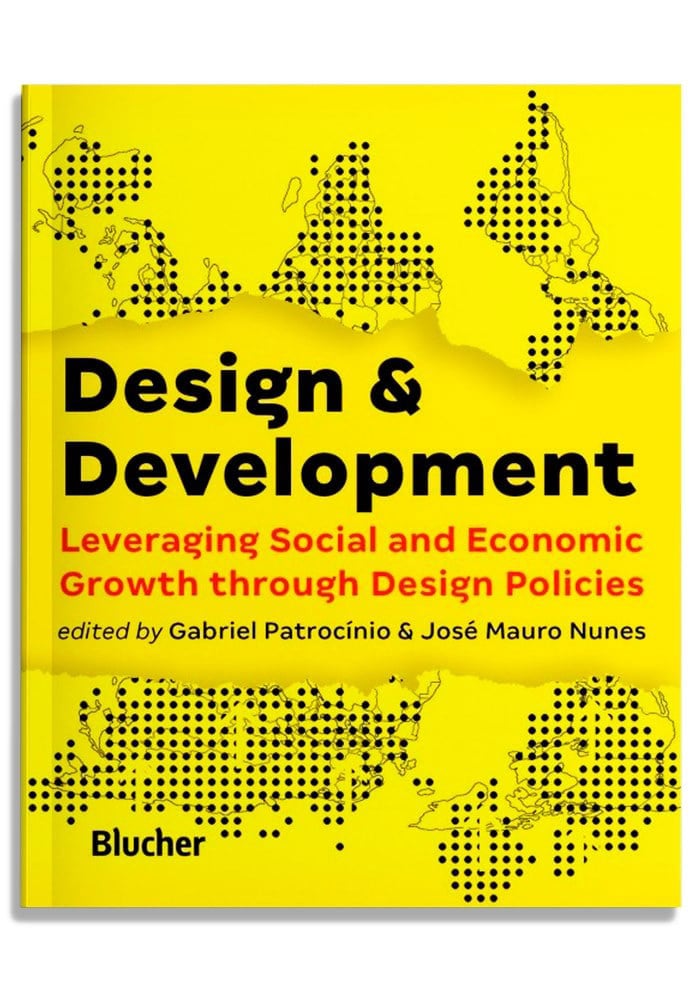Sinopse
"Design & Development: Leveraging Social and Economic Growth through Design Policies" was published originally in Portuguese (Design & Desenvolvimento: 40 anos depois, Blucher, 2015), and finally in 2019 was launched a first edition in English (e-book), available at all online platforms (Amazon Kindle, Apple Books, Google Books, Kobo, etc).
The partnership of WDO (ICSID) and UNIDO in the seventies was the starting point of the book, which brings for the first time two documents from UNIDO as appendices, and has a foreword by the Head of the Brazilian Office of UNIDO, Gustavo Aishemberg, and another by Edna dos Santos-Duisenberg, Advisor from the United Nations Institute for Training and Research, and author of the UNCTAD Creative Economy Report.
The book has contributions such as Victor Margolin, Gui Bonsiepe, Alpay Er, and Mugendi M'Rithaa, among many others. Authors offer their different perspectives coming from the United States, Brazil, Colombia, United Kingdom, Turkey, Kenya, India and China. M'Rithaa, former President of WDO saluted the book as “the most important contribution on this field in the last ten years” (cited in the final remarks of his interview in the chapter Design in Africa: I participate, therefore I am). In Brazil the book was awarded twice - initially at the Objeto:Brasil International Design Award in May 2016, and again at the MCB (Museum of the Brazilian Home) 2016 Design Awards. The jury of this later has acclaimed the book as “a theoretical and academic milestone, with potential to change the current practice and understanding of Design.” After the successful launching in Brazil and Portugal in 2015 and 2016, the book was selected in 2017 to the exhibition Brasil: Hoje at MUDE, Lisbon’s Museum of Fashion and Design. The curator, Frederico Duarte, highlighted in the catalogue: “The first and indispensable book on design and development in the Portuguese language.” In 2018 the book was selected in Spain to be part of BID, the Ibero-American Design Biennial, in Madrid. The book was listed in 2021 in the "Recommended Readings" on the World Design Organization's website. A first e-book edition was launched in Portuguese (2018) and then in English (2019).
Gabriel Patrocínio
Gabriel Patrocínio é designer, doutor em Políticas Públicas de Design pela Universidade de Cranfield (Reino Unido) e professor na UERJ.
Saiba maisJosé Mauro Nunes
José Mauro Nunes é doutor em Psicologia e também professor na UERJ e na Fundação Getulio Vargas.
Saiba maisSumário
About the book
Adélia Borges (I); Letícia Castro (II)
Note to the Portuguese edition
Note to the first English edition
Foreword: UNIDO and industrial design
Gustavo Aishemberg
Foreword: The role of design in the knowledge area
Edna dos Santos-Duisenberg
Why discuss design policies? – An introduction
Gabriel Patrocínio
1. Design for development: mapping the context
Victor Margolin
2. Development patterns of industrial design in the Third World: a conceptual model for newly industrialized countries
H. Alpay Er
3. Design and developing countries: the dialectics of design for need vs. design for development
Gabriel Patrocínio
4. 40 years later
Interview with Gui Bonsiepe, by Gabriel Patrocínio and José Mauro Nunes
5. From Latin America to Latin America: design as a tool for economic and cultural development
Juan Camilo Buitrago & Marcos da Costa Braga
6. From Prebisch to the new developmentalism: theory and practice of industrial policies
Robson Gonçalves & Roberto Aragão
7. Inside India’s eternal “timelessness” – does design throw up more questions than answers?
Ajanta Sen & Ravi Poovaiah
8. Design in Africa: I participate, therefore I am
Interview with Mugendi K. M’Rithaa, by Gabriel Patrocínio
9. Design for development: a perspective of China
Sylvia Xihui Liu & Cai Jun
10. A paradigm shift in policy: integrating design into the European innovation agenda
Gisele Raulik-Murphy, Darragh Murphy & Anna Whicher
11. Consumption and development: perspectives, limits and dilemmas of collaborative consumption in contemporaneity
José Mauro Nunes & Izabelle Fernanda Silveira Vieira
Appendix 1: Development through design
Appendix 2: Basic guidelines for policy of industrial design in developing countries
About the authors
Colophon
Detalhes do livro
- Tipo: eBook
- ISBN: 9788521219033
- Ano da Edição: 2019




